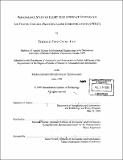Performance study of flight deck interface systems for air traffic control-pilot data link communications (CPDLC)
Author(s)
Fan, Terence P
DownloadFull printable version (27.33Mb)
Alternative title
Performance study of flight deck interface systems for air traffic controller pilot data link
Advisor
James K. Kuchar.
Terms of use
Metadata
Show full item recordAbstract
In an effort to reduce saturation in voice radio channels and to take advantage of space-based communication technologies in a cost-effective basis, data link communication between the flight deck and air traffic control (CPDLC) is gradually coming to the fore. Currently, there are three main flight deck interface designs for CPDLC, and a comparative human factors study of these designs is documented in this thesis. However, in spite of the recent development, there is little coherent understanding on the influence of hardware interface components on performance. To contribute to this understanding, the performance of two flight deck CPDLC interface designs were compared at the Boeing Company, and the result was used to estimate the performance of a third interface design. As a follow-on study, an experiment was conducted to examine the relative performance of four simplified interface configurations for CPDLC. The experiment found that there was little difference in performance (task processing time, accuracy and efficiency) among the four interface configurations in simple communication tasks. However, as the level of difficulty of these tasks increases, a dual interface configuration with separate functionality on each interface required the least amount of time to accomplish the stated tasks. The additional maneuverability provided by a dual-interface configuration with identical functionality on each interface did not appear to lead to significant additional performance gains compared with the dual interface configuration with separate functionality. In general, the single-interface configurations required longer processing times for complicated tasks and were also found to incur higher workload according to the NASA Task Load Index.
Description
Thesis (S.M.)--Massachusetts Institute of Technology, Dept. of Aeronautics and Astronautics, 1999. Includes bibliographical references (p. 125-130).
Date issued
1999Department
Massachusetts Institute of Technology. Department of Aeronautics and AstronauticsPublisher
Massachusetts Institute of Technology
Keywords
Aeronautics and Astronautics